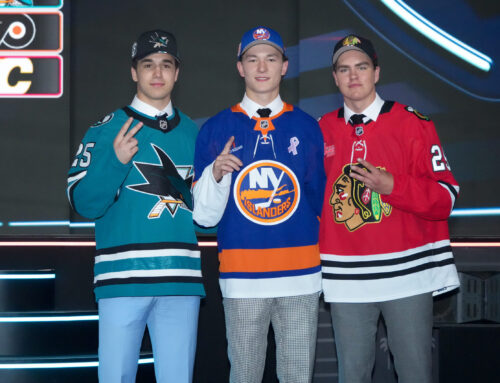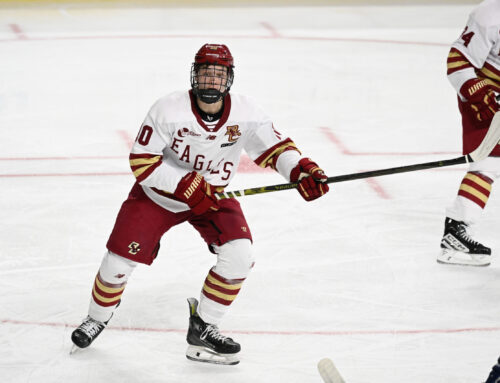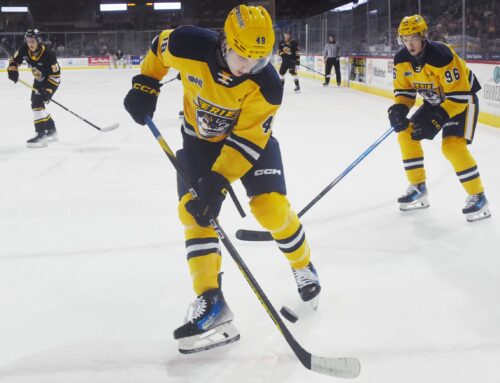
In this week’s Journey, we complete a three-part series looking back on the 2016 NHL Entry Draft. Part Three outlines the 10th-1st selections, and recaps each prospect’s post draft seasons and where they are on the developmental arc.
Look back at Part One (30-21) here.
Look back at Part Two (20-11) here.
10th: Colorado Avalanche – Tyson Jost – North Dakota (NCAA)
2016-17 Stats: 33 GP, 16G, 19A, 35 Points
If there was one thing that Colorado nailed last year, it was drafting Jost 10th overall in June. Unfortunately for Avalanche fans, things trended downward from there.
The BCHL product moved on to North Dakota where he has a successful freshman season finishing second on the team in nearly all offensive statistical categories. He finished first with five power-play goals, and led the team in faceoff percentage.
The all-around center did well to prove himself against a higher level of competition than he faced with Penticton in his draft year, and could be an NHL regular as soon as this fall. He featured in six games at the end of the 2016-17 season following the completion of his collegiate campaign. His biggest adjustment will be the defensive side of the puck in the NHL, but by all accounts, his accountability and high on-ice IQ will help. Jost has an all-star first-line center ceiling, and shouldn’t be worse than a solid second center option in the future.
9th: Montreal Canadiens – Mikhail Sergachev – Windsor Spitfires (OHL)
2016-17 Stats: 50 GP, 10G, 33A, 43 Points
The big Russian blueliner with a cannon of a shot made the Canadiens out of camp, but was sent back to junior to further his development after four games played. He was arguably the best player that Montreal had in their system after being a top ten selection in 2016, but when the 2017 offseason began GM Marc Bergevin shipped him off to Tampa in a deal for forward Jonathan Drouin.
Sergachev should fit in just fine with the Lightning, who have a ton of veterans in the lineup to help bring him along. After a Memorial Cup-winning run with Windsor this spring, there is a chance that he could be on Tampa’s opening night roster. The club currently has five locks on their blueline, with Sergachev battling with fellow prospects such as Jake Dotchin and Slater Koekkoek for the spot. What muddles things is that both are signed to one-way contracts. The Lightning currently have an abnormal amount of right handed shooting defensemen, with Victor Hedman and Koekkoek the only who differ. Sergachev’s big left handed shot should be a power play asset sooner, rather than later.
8th: Buffalo Sabres – Alex Nylander – Rochester Americans (AHL)
2016-17 Stats: 65 GP, 10G, 18A, 28 Points
Following a one-year stay in the OHL in his draft year, Nylander was able to circumvent the AHL-CHL agreement and spend his post draft season in the AHL. Playing most of the campaign as an 18-year-old in the second-hardest league in the world, Nylander showed his immense talent scoring at a rate of .43 points-per-game in 65 contests, which was easily the best rate for an Americans rookie. Add that to the 12 points in seven games for Sweden at the U20’s and it was a successful season for the Swedish prospect.
Alex’s brother William also spent 65 games in the AHL across two seasons before making his full time jump to the NHL last season. The younger Nylander’s path to the NHL may be a bit longer, but not by much as his offensive talent will translate no matter what league he is in. Buffalo surprisingly scored under 200 goals last season (good for 25th in the NHL) and can certainly use a player of Alex’s upside. For some reason among fantasy owners, Nylander is a less-talked about, almost forgotten prospect from the 2016 top ten. Be smart and go out and grab him before he breaks out.
7th: Arizona Coyotes – Clayton Keller – Boston University (NCAA)
2016-17 Stats: 31 GP, 21G, 24A, 45 Points
In the event of a re-draft, there may be some teams that would have thought about selecting Keller higher than the seventh overall that he was taken. Of all the prospects in hockey currently, the St. Louis native has among the highest points ceiling and has a chance to be named among the Calder finalists in 2017.
Keller was terrific for BU this season as a freshman, finishing second behind 2017 NHL draftee Denis Smirnov in rookie scoring and in a tie for 17th among all college hockey scorers. The young forward did miss time due to injury and the World Junior Championships, which makes his point total even more impressive. If you went off points-per-game rate, Keller was among the top five players in college hockey, and the only freshman of the group. He should get a substantial amount of top six and top power play time, even as a rookie in the NHL.
6th: Calgary Flames – Matthew Tkachuk – Calgary Flames (NHL)
2016-17 Stats: 76 GP, 13G, 35A, 48 Points
Just how good Tkachuk was last season was overshadowed a bit by the years that Auston Matthews, Zach Werenski, and Patrik Laine had as rookies in the NHL. Even though he finished seventh (which was low, in my opinion) in the voting for the Calder Trophy, he was a great asset for fantasy owners, even as a first-year player in the league.
In multi-category leagues, Tkachuk is the most valuable. He may never be an 80-point player, but he will fill up the stat sheets on a fairly low salary for the next few seasons. In addition to his 48 points, Tkachuk’s 105 penalty minutes, 142 shots and 65 hits all helped to increase his value. His synergy with Michael Backlund and Michael Frolik helped give the Flames a potent second line capable of putting points on the board and shutting down their opponents. I think he sees a slight uptick in points this season with similar levels of peripheral stats.
5th: Vancouver Canucks – Olli Juolevi – London Knights (OHL)
2016-17 Stats: 58 GP, 10G, 32A, 42 Points
Juolevi didn’t have the best year in 2016-17, but that was partially to do with being the first defenseman drafted, and the expectations that are heaped on you with that honor. Many expected Juolevi to make the Canucks out of camp, but he was correctly sent back to the OHL to continue his development.
He matched his point output with a nearly identical season in his post draft year, but did captain Finland’s World Junior team that faltered so badly in the winter after a gold medal in 2016. The young rearguard still has all the capabilities of a top-four all-around defenseman, it just may take a little longer then some thought. If you are willing to buy low on the Vancouver blueliner, you might get good value when he blossoms.
4th: Edmonton Oilers – Jesse Puljujarvi – Bakersfield Condors (AHL)
2016-17 Stats (Bakersfield): 39 GP, 12G, 16A, 28 Points
Puljujarvi had an interesting rookie season following being drafted in the top-five in 2016. Most thought he was a lock for the third overall spot coming into draft night but Columbus decided instead to upgrade the center ice position. Edmonton kept him around for a quarter of the year, where he posted eight points while playing just over 11 minutes per night. As a volume shooter, Puljujarvi wasn’t getting the looks that he typically had in all other levels.
After the Oilers sent him down to develop further in the AHL, the Finnish winger’s game took off. His shot rate increased from 1.46 at the NHL level to 2.79 at the AHL level, and his points-per-game rate jumped from .36 to .72. Obviously, the difference in competition had a lot to do with these increases, but Puljujarvi was able to develop and gain confidence. I can’t see the fourth overall pick spending too much more time at the AHL level, and Edmonton will become even more dangerous as he grows.
3rd: Columbus Blue Jackets – Pierre-Luc Dubois – Blainville-Boisbriand (QMJHL)
2016-17 Stats: 43 GP, 8G, 37A, 45 Points
After passing over Puljujarvi with the third pick, Columbus decided instead to select Dubois, who had been steadily rising in draft rankings throughout his draft season. That draft season included a 99-point season for Cape Breton in an offensive breakout year for the big center.
2016-17 was not as kind to Dubois, but he still flashed some of the top end talent that had evaluators excited at draft time. He came out of the gates slow for Cape Breton, who traded him to Blainville-Boisbriand midway through the season. With the Armada, he began to show signs of breaking out of his early season slump (by his standards), finishing the season with 59 points in his final 41 games, including the QMJHL playoffs.
2nd: Winnipeg Jets – Patrik Laine – Winnipeg Jets (NHL)
2016-17 Stats: 73 GP, 36G, 28A, 64 Points
In most other years, Laine would have been a shoo-in to win the Calder Trophy for rookie of the year. He ranked seventh among NHL players in goals with 36 and shooting percentage (among players who played 70 games or more) at 17.6%.
Laine is a rare breed of size and skill who should push 40-plus goals for the foreseeable future, and may be the only player in the league that I think could touch 50 unless Alex Ovechkin has a late career renaissance. He certainly would be my favorite to win the Rocket Richard over the next few years, and as early as this season. He should be the second 2016 draftee taken in any fantasy hockey format, but you all probably already knew that.
1st: Toronto Maple Leafs – Auston Matthews – Toronto Maple Leafs (NHL)
2016-17 Stats: 35 GP, 14G, 26A, 40 Points
What else can you say about Matthews that hasn’t already been said? Connor McDavid and Auston Matthews were two of the most hyped number one overall picks of our time, and both not only lived up to their lofty hype, but even have surpassed it.
Matthews was a 40-goal scorer in his rookie season, finishing tied with Nikita Kucherov and just behind Sidney Crosby who led the league with 44. He also ranked in the top 10 in the league in shots (279) and game winning goals (8). Number one overall pick; led the Leafs to the playoffs; Calder Trophy in his trophy cabinet; Quite a year. He will be a fantasy force for seasons to come.
Give Kevin a follow @kleblanchockey for NHL prospect talk and happenings.





 PHI
PHI TOR
TOR ANA
ANA NYI
NYI BUF
BUF CGY
CGY CAR
CAR VAN
VAN STL
STL MTL
MTL FLA
FLA
